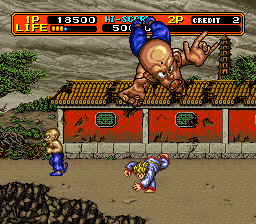Hachoo! sounds like an extremely forceful sneeze, but it’s actually the unusual title for a 1989 arcade beat-em-up from Jaleco. It’s actually meant to sound like a Chinese karate yell (similar to “hi-ya!”) while the kanji on the title screen indicates it’s meant to be pronounced “ha-chou” and also means something to the effect of “broken omen”. It’s actually somewhat clever since it also reveals the premise, as you’re a martial artist traveling over China, in order to defeat a demon that’s attempting to break free of its stone prison.
In the first stage, our kung fu hero jumps on top of a floating cloud, that whisks him through the air with the Great Wall of China in the background. It’s an interesting start to what would be a whimsical trip through the old Orient, as it has a visual style similar to Hot-B’s similarly themed shoot-em-up Cloud Master. Unfortunately, whatever positive first impressions the game makes are immediately shattered when you witness the terrible, jerky animation. Not only does it look bad, but it negatively effects the chop-socky action to the point where the game is almost unplayable.
There are only two buttons – attack and jump. Your attacks will change between punches and kicks depending on whether you’re holding the joystick. Jumping is meant more as a method of evasion, as well as ability to hop over pits, seeing as how there are no jump kicks or any other aerial attacks. The combat is remarkably cheap and clumsy, feeling even jankier than earlier games like Renegade, and is hugely dated compared to contemporary games like Golden Axe. While there is two player simultaneous play, there are no special attacks or extra weapons either, though orbs regularly float in the air, which will restore some life. The enemy AI is also particularly bizarre, as they’ll often march aimlessly back and forth around the screen before engaging the player. This was probably done so the players don’t get overwhelmed since it’s difficult enough to ward off a single enemy at once, much less multiple bad guys, but it looks very strange in action, like wind-up soldiers who aren’t particularly interested in fighting.
There is an emphasis on grappling and throwing, especially since there are relatively large amount of chasms strewn about the levels. In theory you can toss foes here to easily dispose of them, but they can just as easily do the same to you. Indeed, it’s hard to understand how the grappling works because you might grab them, only for them to immediately pull a reversal and chuck you instead. It might be based on how much damage you do to them, it might be based on how quickly you hit the button after you grab them, it might be totally random! What’s curious is that the Japanese ad flyer actually indicates there are three buttons, with one dedicated to throwing. So it’s unclear if the ROM set available in MAME is an alternate version made for only two buttons, or if the flyer is a remnant from an earlier (perhaps location test) design.
Herein lies the key gimmick to Hachoo! – enemies can be tossed left and right, but they can also be lobbed directly at the screen. This is basically the same thing found in Konami’s Teenage Mutant Ninja Turtles: Turtles in Time, but also predates it by about two years. What’s more, it’s actually more graphically impressive – in TMNT, all of the enemies you could throw were foot soldiers, who looked identical outside of color, and there were only a couple of sprite variations. The effect was also implemented via sprite scaling, which was smooth (at least in the arcade version, not so much in the SNES port) but also meant that the image became very pixellated as it zoomed towards the screen. In this game, each of the ten or so enemies has a unique, rather elaborate animation sequence as they’re lifted from the battlefield and lobbed directly at the player.
These are all quite detailed and comical – the sole female warrior somehow becomes disrobed as she’s lobbed through the air, while the eyes of the kyonshi zombies fly outward when they hit the screen. So much more effort was put into these than any other aspect of the entire game, to the point where it was used on the arcade flyer, and even featured in the ending sequence, where you can see each of the animations for all of the enemy characters. While there is a variety of enemies, half the time it feels like you’re fighting variations of the regular bald dudes, so at least you can enjoy seeing these scenes for any ones you weren’t able to throw. In the final battle, you face off against an annoying wizard who just summons more foes to fight. Strangely, despite showing a cutscene of the demon breaking out of his statue every level, you never actually fight him, even though he’s in the background of the climactic encounter.
Hachoo! is Jaleco’s first beat-em-up, and it shows, because it feels like the designers and programmers really couldn’t get a grasp on how they’re supposed to play. It certainly wasn’t their last though, as they continued with the arcade game 64th Street: A Detective Story, as well as the Rushing Beat trilogy on the SNES. While these were marked improvements for the developer, they were ultimately still just Final Fight clones, both mechanically and aesthetically, while Hachoo! at least tried something more unique, even if it’s badly done.
Links:


